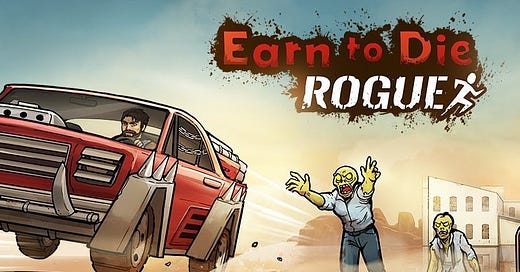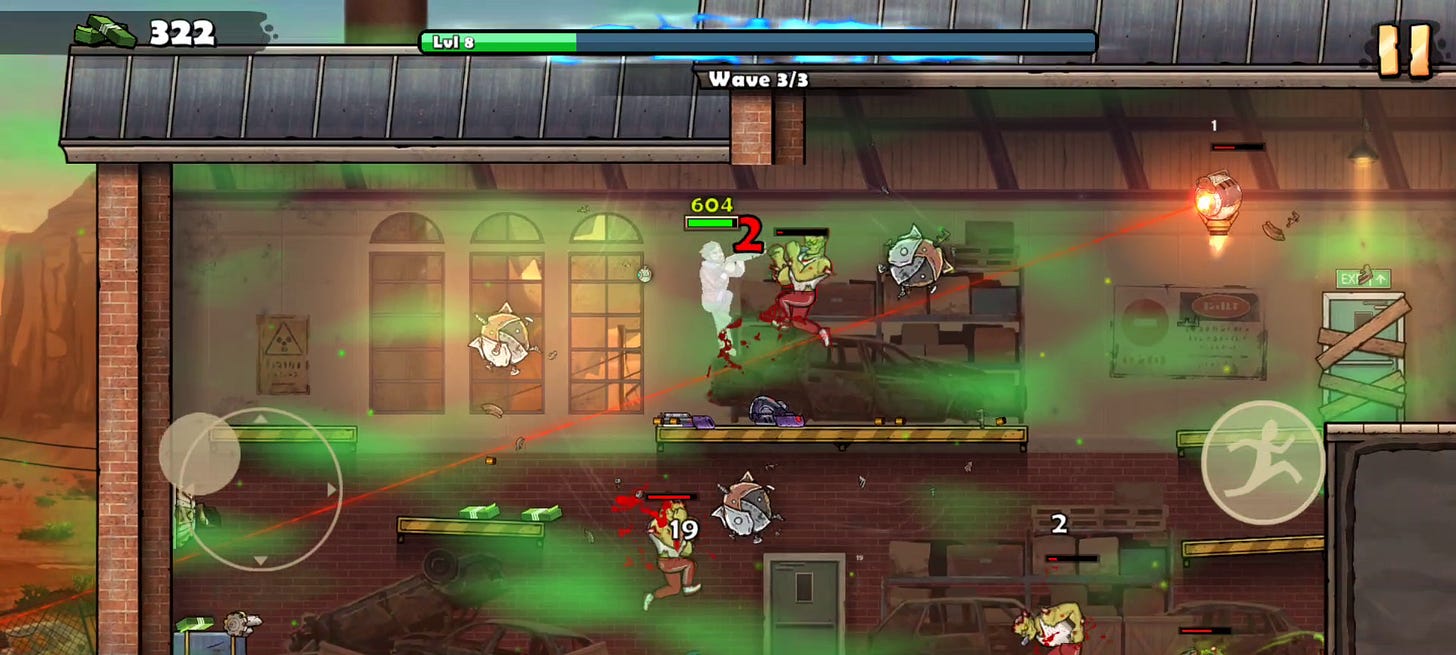Earn To Die Rogue Review
Post-apocalyptic side-scrolling roguelite that can be beaten without spending real-life money. This comes with a significant difficulty spike, however.
Not Doppler isn't particularly famous for its games—by the time of writing this review, they have seven ~4.0 titles to their name, five of which are racing games, the sixth is a shooter-on-rails, and the seventh is a platformer. Three of these games, however, belong to the Earn to Die series—the game of the same name and its sequel, Earn to Die 2, are 2D car-platformers about running over zombies and breaking records while upgrading your vehicle to conquer greater distances in post-apocalyptic United States. However, the formula changes with today's reviewed Earn to Die Rogue, where gameplay shifts to exiting the car and eliminating enemies on foot to recover parts from wrecked vehicles. For this Australian studio's first attempt at this style, it's actually pretty good.
0. TL;DR
Developer: Not Doppler
Release date: 7 May 2024
Genre: Roguelike, Platformer, Racing, Singleplayer, Offline
Price: Free w/ MTX
File size: ~200 MB
Reviewed on: Motorola Moto G82
Pros: Looks and runs rather good; a huge choice of equipment parts and cars; enjoyable driving segments; multiple enemies and levels with rising difficulty
Cons: It really wants you to spend your money; at some point gets very difficult if not watching reward-ads; low-quality music and no effects sounds; can get choppy if things get crazy
Download: Google Play
Gameplay: 5/5
Audio & Visuals: 3/5
Accessibility: 4/5
Monetization: 4/5
FUN FACTOR: 5/51. Gameplay
The plot of Earn to Die Rogue is little more than an excuse for a massive series of levels to conquer—after fleeing a zombie horde, our car gets wrecked, and the spare parts we need are hidden in a facility overrun by various mutants. Our Mad Max-esque hero tightens his shoelaces, grabs a pistol, and kicks open the doors to repair his vehicle and continue the journey.
However, there's no real campaign here—the prologue exists solely to introduce the game's basic mechanics. Each chapter consists of a map with several dozen rooms (usually around 30), filled with mutants and robots of various kinds that must be eliminated to progress. Among the enemies are regular zombies, undead surgeons hurling rotten meat, roller-skating zombie women, vomiting grannies, as well as drones and turrets that fire bullets, rockets, or lasers. The player earns experience for every kill, and leveling up unlocks passive abilities—such as a holographic shield, explosive bullets, floating scrap metal that deals damage, or gravity manipulation allowing for higher jumps.
Every 10 or so levels, you encounter a miniboss with significantly more health (and size) than regular foes, and at the end of each chapter, you face a true boss—like an undead worm that bursts from the ground and spits acid, or a massive zombie with an explosive barrel on its back who hurls smaller zombies at your feet.
Each completed level grants new gear, a bit of cash, and blueprints for upgrading weapons or armor. You can also level up passive traits, boosting health, damage, or movement speed. As for weapons, you can choose between pistols, rifles, and shotguns.
The core roguelike mode can be played on several difficulty levels, and there's also a Heat mode—in exchange for premium currency rewards, it gives enemies various modifiers, making them faster, leaving behind toxic gas clouds, or dealing attacks that inflict burn damage.
There’s also a Challenge Mode, where enemies spawn in waves on every level, and the arena itself gets modified—for example, with toxic clouds that constantly drain the player’s health. In this mode, success isn’t just about dodging enemy attacks but also about eliminating foes efficiently to complete the chapter before dying.
2. Visuals, Audio & Performance
Visually, Earn to Die Rogue holds up quite well—it boasts a unique, comic-book-inspired art style, with detailed 2D environments and enemy designs that are both distinct and memorable. Every upgrade is visually reflected on (or near) the player character, whether it's an astronaut helmet, jet boots, or floating laser-shooting orbs.
The audio, however, is a letdown. The game features a measly two or three bluesy tracks on loop, rendered in low quality—while not ear-grating, it’s hardly worth listening to. Worse yet, there are no gunshot sounds or zombie groans to speak of. After a short while, I just muted the game entirely.
Performance is mostly solid—the game runs smoothly at the display’s refresh rate, though the Heat mode can cause noticeable slowdown or even stuttering when the action gets hectic. This is surprising, considering we’re dealing with sprites and 2D graphics.
3. Accessibility
The game only works in landscape mode and requires both thumbs to control the character—the left side handles movement, while the right controls jumping (shooting is automatic). Most options are labeled, but you have to click into each one to figure out what it does. The settings menu isn't particularly extensive: aside from audio controls, you can change the language, enable a battery-saving mode (which reduces framerate, visual effects, and other elements), or switch to a static joystick. There's no way to resize the UI, nor are there any colorblind modes or similar accessibility options.
4. Ads & Microtransactions
Earn to Die Rogue doesn't force any ads between levels or after deaths—a rare and welcome approach—but it heavily incentivizes watching optional ones for extra rewards, with plenty of opportunities to do so. As for microtransactions, the game isn't overly aggressive, though without some form of "boost," the gameplay can eventually become very grindy and punishing.
The monetization includes a Discount Lab, which encourages spending small amounts on daily, weekly, and monthly randomized rewards, with each purchase unlocking an additional free bonus. Prices range from £0.99 for the cheapest daily pack up to £99.99 for the priciest monthly bundle. There’s also a game pass system that grants premium currency daily—the basic Monthly Pass costs £4.99, while the "Premium" version runs £9.99.
Additionally, the Prestige Pass rewards gold for leveling up your character (the free tier only gives regular cash), with Tier 1 at £6.99 and Tier 2 at £19.99. Gold purchases range from £0.99 for 80 units to £99.99 for 14,000, with a "first purchase bonus" doubling the amount. Players can also buy Skip Ad Tickets—12 for £2.69 or 120 for £19.99.
The prices are steep for a single-player game, but thankfully, you can manage without them.
5. Verdict
Earn to Die Rogue is an excellent game that absolutely delivers on its promises. There's plenty to do here, offering hours of fun—especially if you play without any paid boosts or optional aids. The developers could still improve optimization and audio design, and the microtransaction system feels out of touch with single-player game standards. But beyond that? I've got no complaints.













